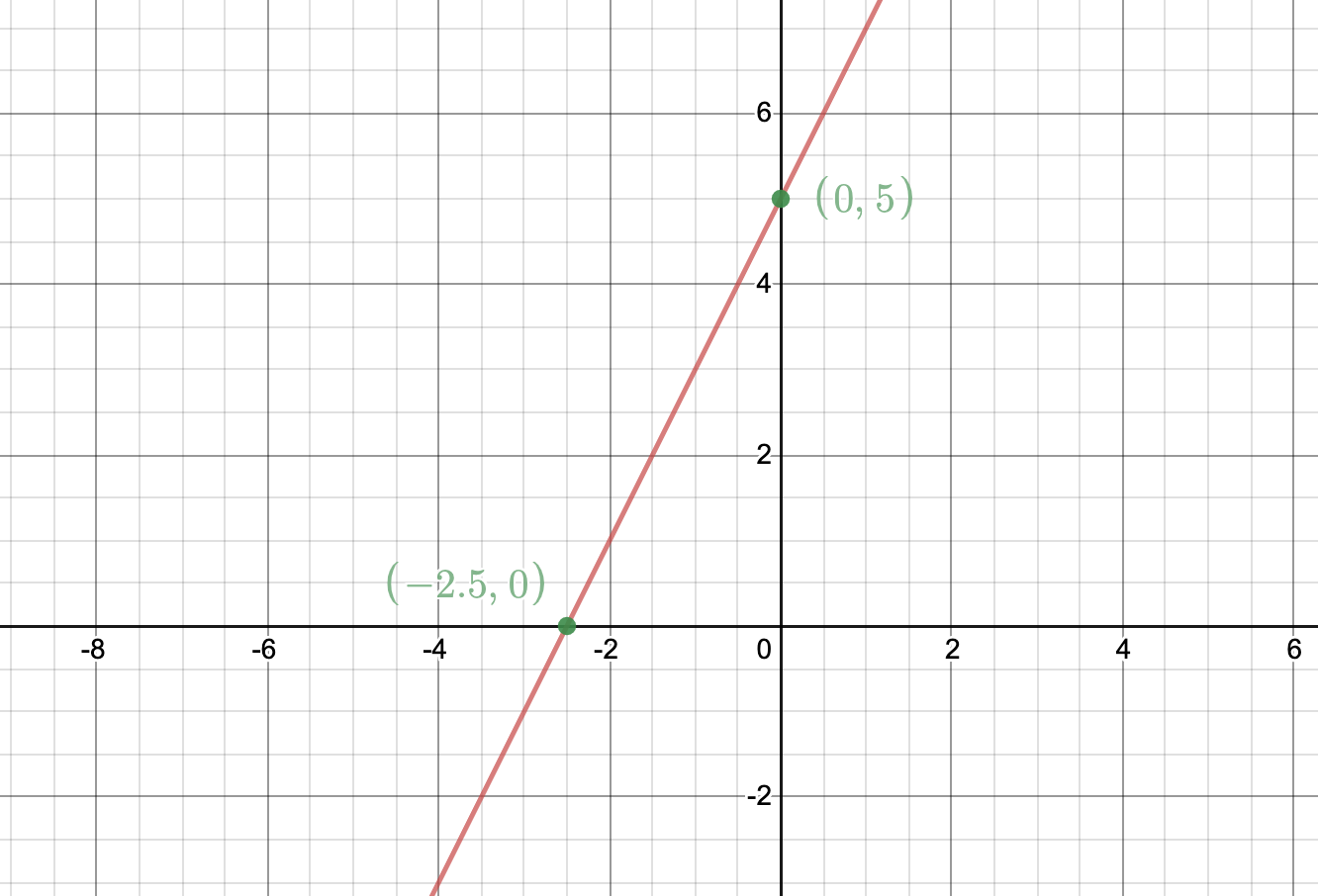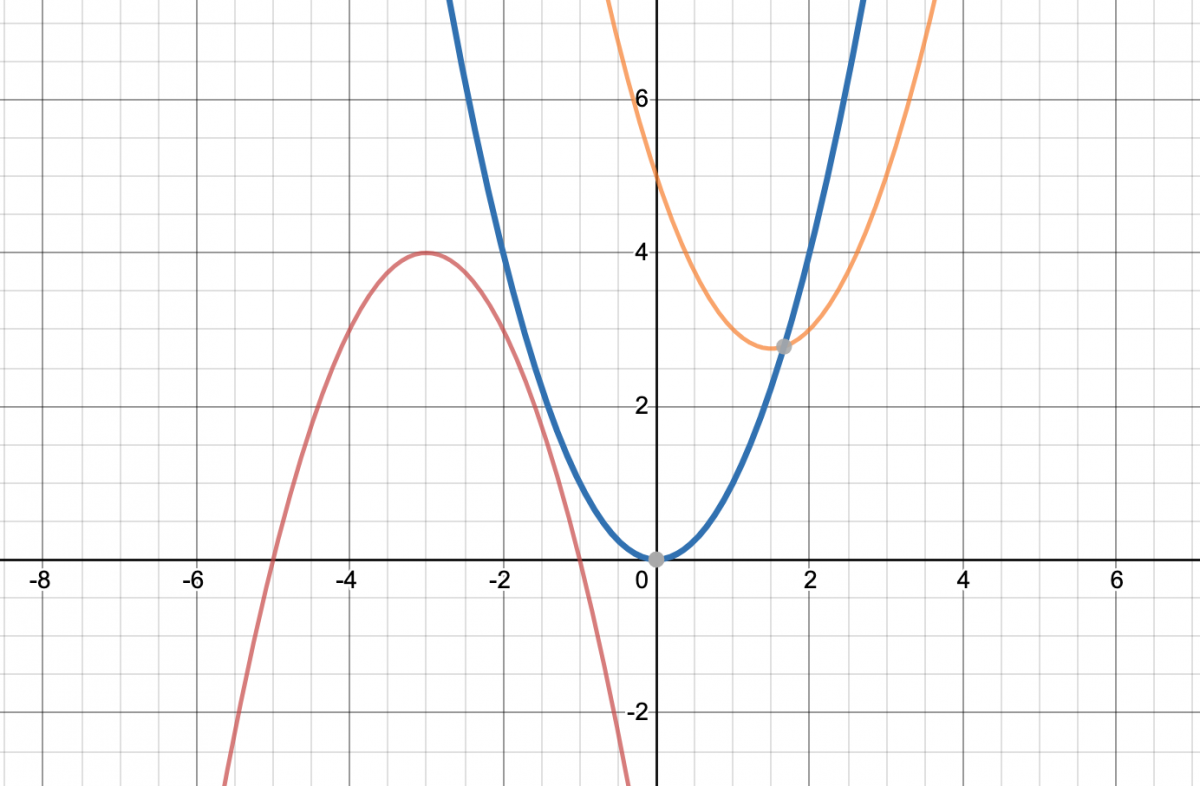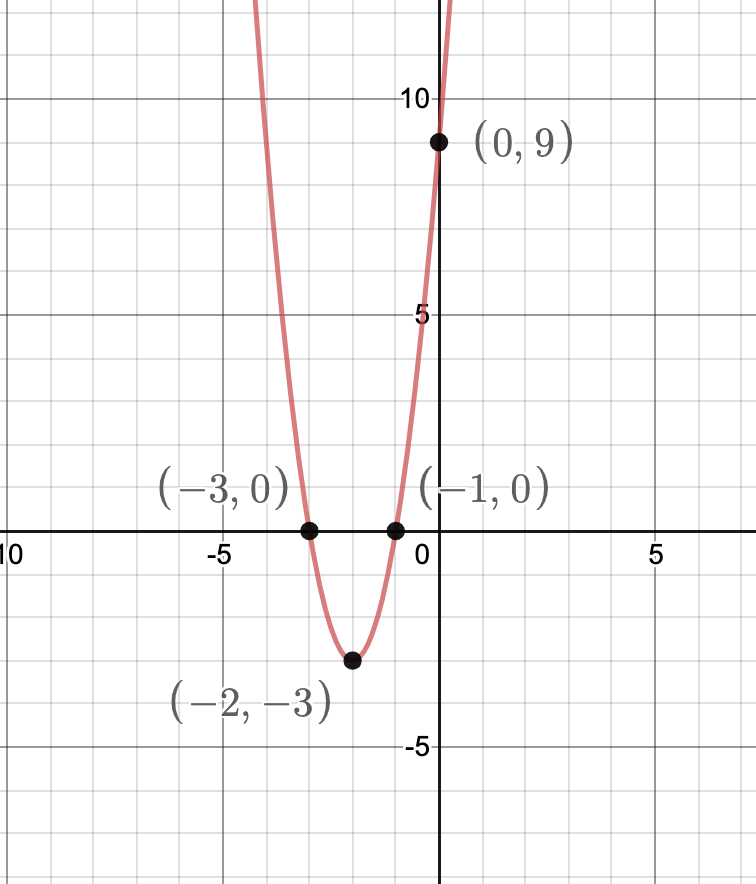Hi Everyone!
On this page you will find some material about Lesson 13. Read through the material below, watch the videos, and follow up with your instructor if you have questions.
Lesson 13: Graphs of Quadratic Functions & Vertex of a Parabola
Table of Contents
Resources
In this section you will find some important information about the specific resources related to this lesson:
- the learning outcomes,
- the section in the textbook,
- the WeBWorK homework sets,
- a link to the pdf of the lesson notes,
- a link to a video lesson.
Learning Outcomes.
- Identify the concavity of the parabola by analyzing the quadratic expression.
- Find the $x$- and $y$-intercepts of a quadratic function.
- Find the vertex of a parabola by completing the square and by using the vertex formula.
- Find the equation of the axis of symmetry.
- Graph a parabola by labeling the $x$- and $y$-intercepts, the vertex and the axis of symmetry.
Topic. This lesson covers
Section 7.4: Graphs of Quadratic Functions, and
Section 7.5: Vertex of a Parabola.
WeBWorK. There are four WeBWorK assignment on today’s material:
ShiftingParabolas
ParabolaLab
ParabolaVertices-CtS
ParabolaVertices-VertexFormula
Lesson Notes.
Video Lessons.
Video Lesson 13 – part 1 (based on Lesson 13 Notes – part 1)
Video Lesson 13 – part 2 (based on Lesson 13 Notes – part 2)
Warmup Questions
These are questions on fundamental concepts that you need to know before you can embark on this lesson. Don’t skip them! Take your time to do them, and check your answer by clicking on the “Show Answer” tab.
Warmup Question 1
Consider the line given by $y=2x+5$. Find the $x$- and $y$-intercepts. Graph the line by labeling these two points.
Show Answer 1
For the line given by $y=2x+5$, we have
$\bullet$ $x$-intercept
Set $y=0$.
$$2x+5=0$$
$$2x=-5$$
$$x=-\dfrac{5}{2}$$
The $x$-intercept is $\left(-\dfrac{5}{2},0\right)$.
$\bullet$ $y$-intercept
Set $x=0$.
$$y = 2\cdot 0 + 5 = 5$$
The $y$-intercept is $(0,5)$.
$\bullet$ Graph

(graph of the line $y=2x+5$ with the $x$- and $y$-intercepts labeled)
Warmup Question 2
Given the expression $y=2x^2-7x+3$, find $y$ when $x=-\dfrac{1}{2}$.
Show Answer 2
$$y=2\left(-\dfrac{1}{2}\right)^2-7\left(-\dfrac{1}{2}\right)+3$$
$$=2\left(\dfrac{1}{4}\right)+\dfrac{7}{2}+3$$
$$=\dfrac{1}{2}+\dfrac{7}{2}+3$$
$$=4+3$$
$$=7$$
Review
If you are not comfortable with the Warmup Questions, don’t give up! Click on the indicated lesson for a quick catchup. A brief review will help you boost your confidence to start the new lesson, and that’s perfectly fine.
Quick Intro
This is like a mini-lesson with an overview of the main objects of study. It will often contain a list of key words, definitions and properties – all that is new in this lesson. We will use this opportunity to make connections with other concepts. It can be also used as a review of the lesson.
A Quick Intro to Graphs of Quadratic Functions & Vertex of a Parabola
Key Words. Quadratic function, graph, parabola, $x$- and $y$-intercepts, quadratic equation, vertex, completing the square, vertex formula, axis of symmetry.
The graph of a quadratic function
$$y=f(x)=ax^2+bx+c \qquad (a\neq 0)$$
is a parabola. The graph below shows three parabolas.

From left to right:
- Parabola 1 (in red): concave down, intersects the $x$-axis at two points.
- Parabola 2 (in blue): concave up, intersects the $x$-axis at one point only.
- Parabola 3 (in orange): concave up, does not intersect the $x$-axis.
When graphing a quadratic function $f(x)=ax^2+bx+c$, consider the following.
$\bigstar$ The parabola is
$$\begin{cases}\text{concave up}, & \text{ if } a\text{ is positive},\\ \text{concave down}, & \text{ if } a\text{ is negative.} \end{cases}$$
$\bigstar$ The $x$-intercepts are the points where the parabola crosses the $x$-axis. These points are of the form $(x,0)$. We find them by setting $y=0$ or
$$ax^2+bx+c=0.$$
The number of $x$-intercepts is
$$\begin{cases}0 & \text{ if } ax^2+bx+c=0 \text{ has no real solution}\\ 1 & \text{ if } ax^2+bx+c=0 \text{ has only one real solution}\\2 & \text{ if } ax^2+bx+c=0 \text{ has two real solutions.} \end{cases}$$
$\bigstar$ The $y$-intercept is the point where the parabola crosses the $y$-axis. This point is of the form $(0,y)$. We obtain it by plugging $x=0$ into $f(x)=ax^2+bx+c$.
$$y=f(0) = a\cdot 0^2+b\cdot 0 +c = c$$
The $y$-intercept always exists, is unique, and is given by $(0,c)$.
$\bigstar$ When the parabola is concave up, there is a point that is the highest one on the graph. When the parabola is concave down, there is a point that is the lowest one on the graph. This point is called the vertex of the parabola. We can find the coordinates of the vertex in two ways.
- By completing the square, we can rewrite $f(x)$ as $$f(x)=a(x-h)^2+k.$$ In this case, $(h,k)$ is the vertex.
- By using the vertex formula, the vertex is $$\left ( -\dfrac{b}{2a},f\left(-\dfrac{b}{2a}\right)\right)\quad\text{ or }\quad \left ( -\dfrac{b}{2a},\dfrac{4ac-b^2}{4a}\right)\right).$$
$\bigstar$ The axis of symmetry is the vertical line $x=h$ passing through the vertex, where $h$ is the $x$-coordinate of the vertex.
$\bigstar$ In general, how many intersection points can a circle and a line have?
Video Lesson
Many times the mini-lesson will not be enough for you to start working on the problems. You need to see someone explaining the material to you. In the video you will find a variety of examples, solved step-by-step – starting from a simple one to a more complex one. Feel free to play them as many times as you need. Pause, rewind, replay, stop… follow your pace!
Video Lesson
A description of the video
- Find the $x$- and $y$-intercepts, the vertex and the graph of the parabola $y=-2x^2-4x+5$.
- Find the $x$- and $y$-intercepts, the vertex and the graph of the parabola $y^2+2y+x=0$.
Try Questions
Now that you have read the material and watched the video, it is your turn to put in practice what you have learned. We encourage you to try the Try Questions on your own. When you are done, click on the “Show answer” tab to see if you got the correct answer.
Try Question 1
Let $y = 3x^2+12x+9$.
(a) Find the vertex using both methods: completing the square and using the vertex formula.
(b) Find the $x$- and $y$-intercepts.
(c) Sketch the graph.
Show Answer 1
(a)
$\bullet$ by completing the square
$$3x^2+12x+9 = 3(x^2+4x)+9$$
$$=3(x^2+4x+4)-12+9$$
$$=3(x+2)^2-3$$
The vertex is $(-2,-3)$
$\bullet$ by the vertex formula
We have $a=3$, $b=12$ and $c=9$. By the vertex formula, the vertex is
\[\left(-\dfrac{b}{2a},f\left(-\dfrac{b}{2a}\right)\right)= \left(-\dfrac{12}{2\cdot 3},f\left(-\dfrac{12}{2\cdot 3}\right)\right)\]
\[=\left(-2,f\left(-2\right)\right) = (-2, 3(-2)^2+12(-2)+9) = (-2, -3).\]
(b) The $x$-intercept is obtained by setting $y=0$:
$$3x^2+12x+9 =0$$
$$ 3(x^2+4x+3)=0 $$
$$ x^2+4x+3=0$$
$$(x+3)(x+1)=0$$
$$x=-3\text{ or } x=-1$$
The $x$-intercepts are $(-3,0)$ and $(-1,0)$. To obtain the $y$-intercept, we set $x=0$:
\[y = 3\cdot 0^2+12\cdot 0 +9 =9.\]
The $y$-intercept is $(0,9)$.
(c)

(Graph of the parabola $y = 3x^2+12x+9$
with the $x$- and $y$-intercepts and the vertex labeled)
WeBWorK
You should now be ready to start working on the WeBWorK problems. Doing the homework is an essential part of learning. It will help you practice the lesson and reinforce your knowledge.
WeBWork
It is time to do the homework on WeBWork:
ShiftingParabolas
ParabolaLab
ParabolaVertices-CtS
ParabolaVertices-VertexFormula
When you are done, come back to this page for the Exit Questions.
Exit Questions
After doing the WeBWorK problems, come back to this page. The Exit Questions include vocabulary checking and conceptual questions. Knowing the vocabulary accurately is important for us to communicate. You will also find one last problem. All these questions will give you an idea as to whether or not you have mastered the material. Remember: the “Show Answer” tab is there for you to check your work!
Exit Questions
- Change the title to exclude “functions”. How is the graph of a quadratic equation in two variables related to the equation itself?
- In other words what is the graph of an equation in general?
- Which elements of the graph can we easily see from the equation when it is in standard form?
- Which elements of the graph can we easily see when we write it in factored form: $y=(x-a)(x-b)$?
- Which elements of the graph can we easily see when we complete the square and write it in the form: $$y-k=m(x-h)^2 \text{ or } \dfrac{1}{m}(y-k)=(x-h)^2.$$
- In this last form, what is the relationship between $m$ and the shape of the graph? What does the graph of $x-k=(y-h)^2$ look like?
$\bigstar$ (1) Let $f(x) = -x^2-6x-7$.
(a) Write the function in the form $f(x) = a(x-h)^2+k$ by completing the square.
(b) Identify the vertex and the axis of symmetry.
(c) Find the $x$- and $y$-intercepts.
(d) Graph the parabola and the axis of symmetry on the graph paper. Label the coordinates of the vertex and write the equation of the axis of symmetry.
$\bigstar$ (2) Use the vertex formula to find the coordinates of the vertex of the parabola given by $g(x) = -2x^2+x+1$.
Show Answer
(1)(a)
$$f(x) = -x^2-6x-7 $$
$$f(x)= -(x^2+6x+9-7+9) $$
$$f(x)=-(x+3)^2+2 $$
$$f(x)= -(x-(-3))^2+2 $$
(b) $$ \textit{compare this to } a(x-h)^2+k$$
Notice that $a=-1$, $h=-3$ and $k=2$.
The vertex is $(h,k)=(-3,2)$.
The equation of the axis of symmetry is $x=h$, that is, $x=-3$.
(c) To find the $x$-intercepts, we set $f(x)=0$ and solve for $x$.
\[f(x) = 0\quad \Longrightarrow\quad -x^2-6x-7=0 \quad \Longrightarrow\quad x^2+6x+7=0\]
Let’s use the quadratic formula to find $x$.
\[x=\dfrac{-b\pm\sqrt{b^2-4ac}}{2a}\]
We have that $a=1$, $b=6$ and $c=7$.
\[x= \dfrac{-6\pm\sqrt{6^2-4\cdot 1\cdot 7}}{2\cdot 1} = \dfrac{-6\pm\sqrt{8}}{2}= \dfrac{-6\pm2\sqrt{2}}{2}=-3\pm\sqrt{2}\]
So the $x$-intercepts are $(-3+\sqrt{2},0)$ and $(-3-\sqrt{2},0)$, that is, $(-1.6,0)$ and $(-4.4,0)$, approximately.
$\bullet$ To find the $y$-intercept, we need to find $f(0)$.
\[f(x) = -x^2-6x-7 \quad \Longrightarrow\quad f(0)=0^2-6\cdot 0 -7 = -7 \]
So the $y$-intercept is $(0,-7)$.
(d)

(2) According to the vertex formula, the vertex is $\left(-\;\dfrac{b}{2a},g\left(-\;\dfrac{b}{2a}\right)\right)$ where $g(x) = ax^2+bx+c$. When $g(x) = -2x^2+x+1$, we have $a=-2$, $b=1$ and $c=1$. So
\[-\;\dfrac{b}{2a} = -\;\dfrac{1}{2\cdot (-2)} = -\;\dfrac{1}{-4} = \dfrac{1}{4},\]
and
$$g\left(-\;\dfrac{b}{2a}\right) = g\left(\dfrac{1}{4}\right) = -2\left(\dfrac{1}{4}\right)^2+\dfrac{1}{4}+1$$
$$= -2\cdot\dfrac{1}{16}+\dfrac{1}{4}+1 = -\dfrac{1}{8}+\dfrac{1}{4}+1$$
$$ = -\dfrac{1}{8}+\dfrac{2}{8}+\dfrac{8}{8} =\dfrac{9}{8}$$
The vertex is $\left(\dfrac{1}{4}, \dfrac{9}{8}\right)$.
Need more help?
Don’t wait too long to do the following.
- Watch the additional video resources.
- Talk to your instructor.
- Form a study group.
- Visit a tutor. For more information, check the tutoring page.



